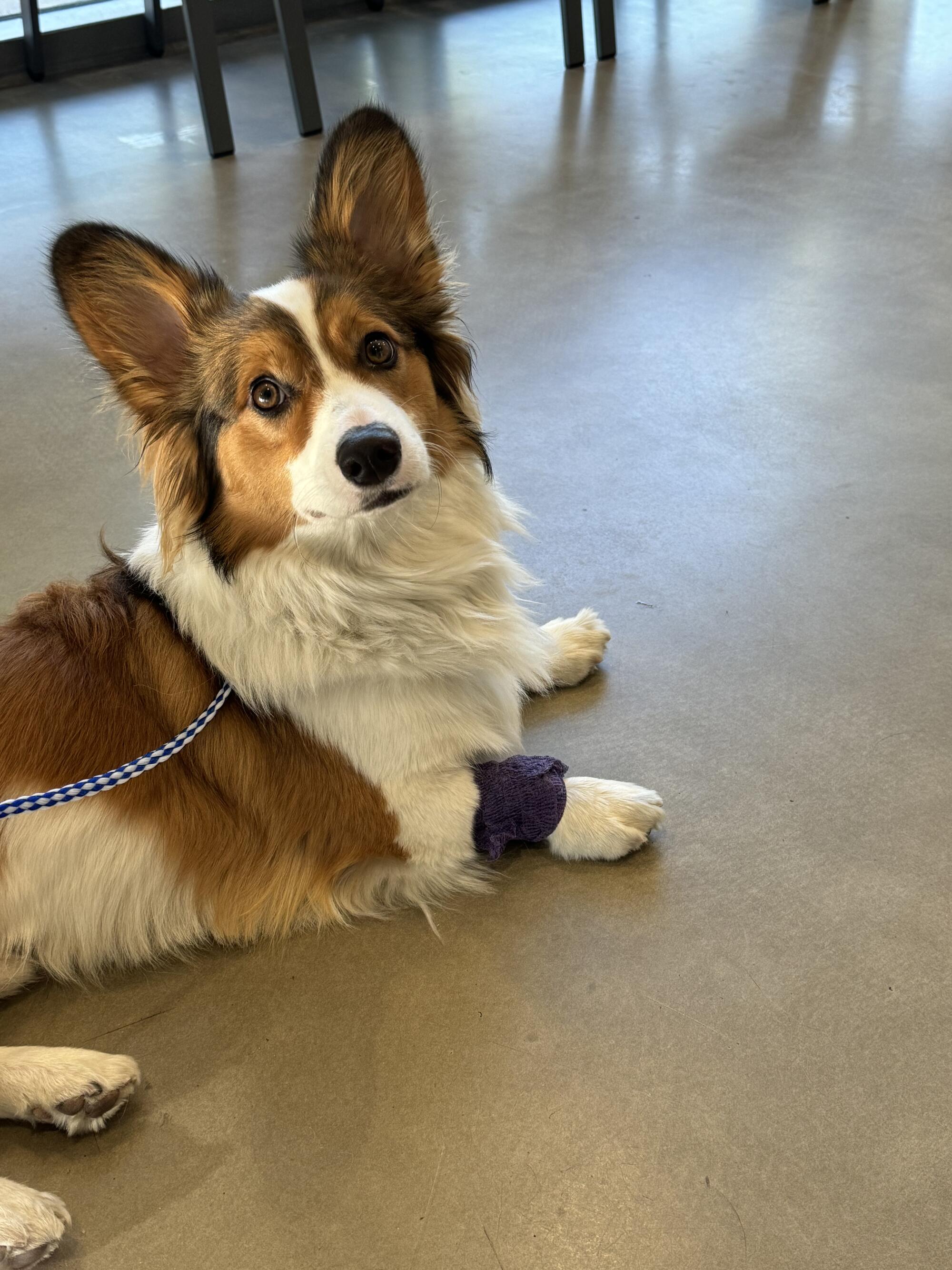Two things are certain in pet parenting: 1) your furry loved one will one day have to visit the vet and 2) the cost of veterinary care is increasing, rising more than 60%, over the last decade, according to a recent New York Times report.
Stacie Straw, in Long Beach, Calif., spent about $30,000 in 2022 on her English Bulldog rescue, Blanche, which she mostly paid for with a CareCredit card at zero interest, she said in response to a Times survey inquiring about readers’ vet expenditures. The cost was due to the “unfortunate confluence,” she said, of the dog needing ACL surgery and then developing mast cell cancer. Ultimately, Blanche passed away after several months of treatment.
“I have a lot of empathy for vets because they’re doing the best they can,” Straw said in a follow-up interview. “But it’s really hard and expensive for most people — it’s difficult to spend $100 to take your dog to the vet just to know if there’s an issue. That’s not chump change. And you may have to make trade-offs in your spending decisions to [pay for] that.”
Stacie Straw’s English bulldog rescue, Blanche.
(Stacie Straw)
Ballooning veterinary costs are not necessarily your mom and pop vet’s fault. A combination of factors in the industry is driving up vet bills. Drugs and vaccines are more expensive than ever. As is the cost of staffing vet offices, rent, utilities and medical equipment. Because there are more advanced medical technologies and treatments for pets now — MRIs, allergy testing, even acupuncture — there’s often more to charge for. And the ongoing corporatization of independent veterinary practices — in which big businesses look to maximize profits — is driving costs through the roof.
In addition to readers who have emptied their pockets at the vet, we heard from more than two dozen veterinarians across the country in response to our survey, nearly all of them citing the exorbitant cost of their veterinary school tuition. Many of them also noted that vets have a higher suicide rate than the general population — between 2.1 to 3.5 times higher, according to a 2019 Centers for Disease Control and Prevention study.
Dr. Jessica Bachmann, of Ira, Vt., noted her “$400,000, eight-year education” to become a veterinarian.
But an industry in crisis doesn’t make caring for our pets any easier. If you’re enduring the outrageous cost of veterinary care, take some solace that you are not alone. Here’s what some Times readers had to say on the topic.

Raquel Cypert’s rescue chihuahua-pug, Luna.
(Raquel Cypert)
Raquel Cypert and Luna, Upland, CA
Highest vet bill: $3,800 — after having spent $800 the day prior on Luna at the vet.
What happened: “Luna became really lethargic and was vomiting one day. I took her to our regular vet and they ran some tests and gave her some fluids and said it was probably a stomach virus and sent us home. She spent the night vomiting and seizing. The next morning I took her back to that vet who said they could put her down or she could go to an emergency hospital.
I red lined [my] Audi a couple of times to the hospital and we ran in where they were waiting for us. The vet called us into the room about 20 minutes later and said she has Addison’s disease which is a deficiency of her stress hormones and she would need emergency meds and IV fluids and need to stay overnight to get her stable. $3,800 later we got our baby back.”
The outcome: “She needs monthly injections and daily meds but her condition is pretty manageable.”
Any cheaper alternative care options? “Because I am a nurse, I am able to inject her myself. So it saves about $1,000 a year avoiding monthly vet visits.”
William G Keiner and his dog, Los Angeles
Highest vet bill: $400 quickly escalated to $5,000 “before we were forced to decline treatment.”
What happened: “Our dog, about one year old, slipped his leash and ran into a car. Being a rescue who had distemper, he does not qualify for pet insurance. So when we took him to the emergency vet, we were presented with an ever-escalating stream of estimates … before we were forced to decline treatment. Essentially they admitted our dog, quoted a price to assess him and give him pain meds. They assessed and came out with a higher estimate. Went back in, came out with another higher estimate. This happened two-three times before we had to decline treatment. We still ended up paying close to $2,000. The vets were neither able to reset the broken leg or properly splint the leg.”
The outcome: “We opted for pain killers to get us through the weekend [and] to see a non-profit vet.”
Any cheaper alternative care options? “We took our dog to a non-profit vet who worked with the rescue group we foster for. He was treated but it didn’t go well. The pins they put in his leg got infected. This vet, we learned, was [ultimately] shut down by the city. We eventually found an independent vet who agreed to a reasonable [price]. Still thousands of dollars to remove the pins, which did the trick.”
Misty Dailey and Elfin, Spring Branch, TX
Highest vet bill: $2,200 (in Sacramento, Calif., 1992)
What happened: “Gastric Tortion. Deep barrel-chested dogs like Dobermans, boxers, Great Danes, etc., can have a tendency to woof their food down. If it’s not watered down or the bowl raised so they don’t have to bend down so much, it causes too much air to go into their gut. Their gut starts expanding (like a horse with colic) and their intestines will twist, killing them. I was leaving for a weekend in Lake Tahoe and saw my Doberman was all swelled up and looked like a chubby Shetland pony. My vet saw Elfin, whisked her away from me and took her to X-ray. She said she’d never seen a dog so bloated and still alive. She put her under, sliced her belly open, whooshed the air out of her, and then basically stitched her organs to the side of her so if it ever happened again, she wouldn’t twist up.”
The outcome: “I began raising up all my dogs’ dry food meals off the floor so it wouldn’t happen again.”
Any cheaper alternative care options? “No. I was grateful to pay the $2,200. They saved her! Elfin has [since] gone to Heaven.”

Michelle Min’s newly adopted dog, Lola.
(Michelle Min)
Michelle Min and Lola, San Gabriel Valley, CA
Highest vet bill: Over $1,300 (in 2013)
What happened: “One heart ultrasound [was] needed for a freshly adopted (doctor mandated) ADA dog, whom I completely adored, she saved my life. I was on a fixed income and pet insurance refused to cover it, despite collecting premiums. Turned out that she had serious, congenital heart issues. Lifelong medications (about five a day) and expensive, home cooked chicken breast/rice/veg diet followed for her whole life. She was worth every penny, there was nothing I wouldn’t have done for her, but I cannot go through this again. Too painful, not to mention the expense.”
The outcome: “It only confirmed the vet’s diagnosis prior to the test. She was already given meds and supplements to address her heart problems. No changes or adjustments were made following the test.”
Any cheaper alternative care options? “No. It’s outlandishly expensive to properly care for your companion, even if she serves a life-saving purpose as an ADA animal. This may be the hardest part. Living as a disabled person on a fixed income, I (willingly) sacrificed for years, so she could have proper care.”

Daniel Smith-Ramirez’s dog, Legoshi.
(Daniel Smith-Ramirez)
Daniel Smith-Ramirez and Legoshi, Cocina, CA
Highest vet bill: $2,300 with $4,000 on the horizon.
What happened: “This month, my dog has had bouts of stomach issues. He’s had to be treated with five different meds and hospitalized for three days. He will also potentially need an endoscopy. [He’s] been diagnosed with an ulcer, but [the] exploratory endoscopy [will] confirm.”
The outcome: “The first set of meds was not [helpful], so now we are trying stronger meds.”
Any cheaper alternative care options? “This is actually the cheapest in the area. We were told that other hospitals would charge roughly $10,000-20,000.”
Juan Chavez and Sugar, Pasadena
Highest vet bill: $10,000
What happened: “Our dog, Sugar, was hospitalized for pancreatitis. She had to be interned in a pet hospital for 24 hours, for one week.”
The outcome: “She was put to sleep after seven days.”
Any cheaper alternative care options? “No. Our neighborhood is notorious for good, but high-cost, vets. I’m under no illusion about getting cheaper vets, but perhaps we need to shop around outside our location using Reddit or NextDoor recommendations.”

Shelley Keith’s dog, Olive.
(Shelley Keith)
Shelley Keith and Olive, Sherman Oaks, CA
Highest vet bill: $3,000
What happened: “My dog was having seizures and I took her to an ER animal hospital.”
The outcome: “Lots of diagnostic tests but nothing wrong.”
Any cheaper alternative care options? “No.”
Jamie Tran and Grady, Santa Maria, CA
Highest vet bill: $12,149.43
What happened: “My dog that I had just adopted five days before became very ill out of the blue. He was so critical that they weren’t sure he’d make it through the night. He remained critical for the next several days with no definitive diagnosis. He was treated for potential sepsis, anaphylaxis and leptospirosis.”
The outcome: “I know that if he had still been at the shelter, they would have made the decision to let him go. Because they treated him for a myriad of things based on his symptoms, they were able to get him stable. When they discharged him, they provided seven medications to continue for two-three weeks after. Oddly enough, they discharged him saying there was nothing more that they could do and we would need to continue treatment at home and see if he continues to improve. I didn’t leave with the most confidence that he would make a full recovery. I don’t regret paying to save his life, but it’s something I’ll be paying for a long time.”
Any cheaper alternative care options? “No. The cost of veterinary care is quite expensive. Unfortunately where I live, the options for care are quite limited or nonexistent. They potentially wanted to transfer him elsewhere to be seen by a specialist. The options for that were an hour or two away as there are no specialists available anywhere closer. If your pet is in need of a specialist, they most likely are not well enough to travel long distance to receive the care they need.”







